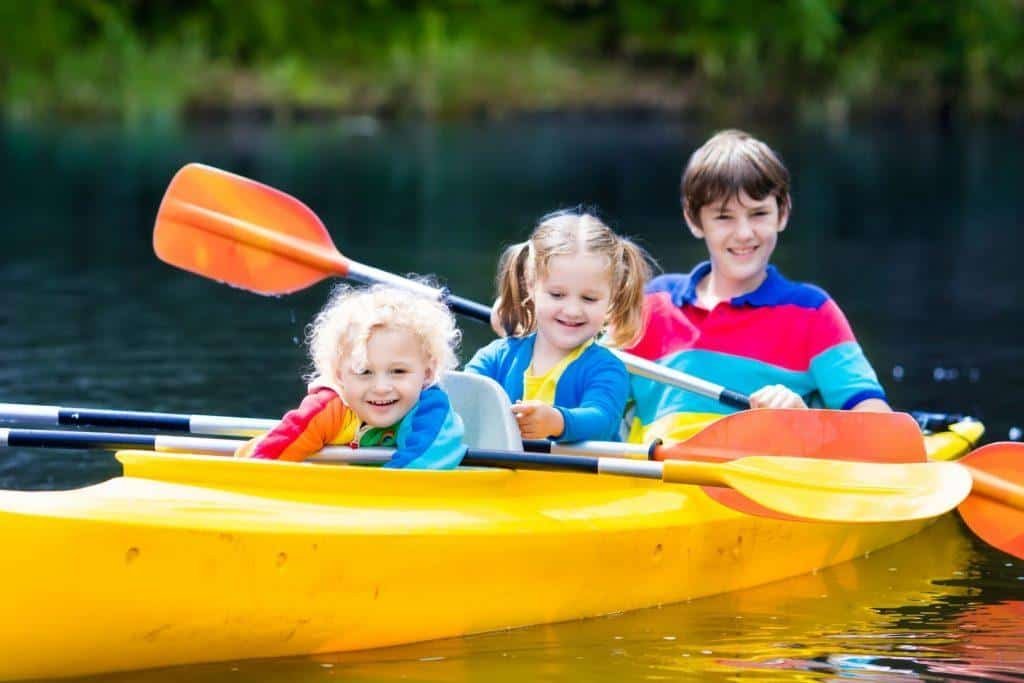Many would shun the idea of bringing kids along on a kayaking trip. Kids can be a handful if they get either too excited or bored. Safety is also a major concern when you have a toddler with you on a kayak.
But why deprive them of the experience and the opportunity? You can actually go kayaking with your toddler if you take a few things into consideration.
How to Kayak With a Toddler
Plan, Plan, Plan
You plan before you go out to do any activity, that’s a given. But if you are bringing your toddler along, you should double that effort and put more time in planning. Here are a few tips.
If you are not that well experienced in paddling a kayak, taking a toddler on the water is a big no-no, unless you bring along an experienced paddler. There should be one experienced paddler for each child.
If this will be the first time for your child to ride a kayak, start with calm water and light current. Protected bays, small lakes, and slow rivers are great for beginners. It will also help develop your kid’s skills while reducing stress levels.
Toddlers generally have shorter attention spans than adults so you should consider this when planning the length of the kayaking activity. Keep it short so as not to bore your kid, but still long enough to develop enthusiasm.
At least a couple of months before the kayaking trip, sign your toddler up for kayaking and swimming lessons. Check out the local community pool if there are lessons available. This will help them prepare for both enjoyment and safety.
Packing for Adventure
Packing for kids is just like packing for adults with a few tweaks. You can even involve your toddler in this activity by letting him or her decide what to bring along. Just double-check after. Here are the basic things to bring in a kayaking trip.
Fluids and Food. Keep yourself and your toddler well hydrated during the activity. The paddling effort, when combined with the heat of the sun, increases the need for fluid intake, so have a bottle of water close at hand. Water pillows that fit under the kayak seats are also a good option. Food replaces lost energy so bring along easy-to-carry ones like hard-boiled eggs, smoked salmon, mangoes, apples, nuts, cheese, dried fruits and veggies, bars, and cookies.
Clothes. Bring comfortable clothes that are breathable so they can be layered if the weather gets colder. Bringing extras is always a good idea as kids have this uncanny ability to get themselves dirty. A wide-brimmed hat helps protect from the heat of the sun or rain when it pours. Boots protect from hazards like broken glass or sharp rocks. Bring rain gear in case of a heavy downpour. Keep clothes in dry bags and strap them tightly inside the boat.
Accessories. These are optional, but can make the trip more enjoyable. Sunglasses protect your eyes from the harsh sunlight. An emergency whistle is effective for calling attention; maps and compasses for navigating the terrain and the waters. Umbrellas protect from the sun and rain.
This is supposed to be an adventure for your toddler so bring items along that will spark that excitement.
- Binoculars
- Fishing pole
- Books
- Small pop up tent if you plan to stay longer
- Pencil and notepad
- Songbooks
The ‘Day’
When the day of the kayaking trip comes, review the procedures with your toddler according to what has been taught in the courses. Discuss important items thoroughly with your kids, and answer questions as clearly and as plainly as you can.
Do a safety check before going into the water with your toddler. Personal Flotation Devices or PFDs are required by law. Choose the right fit for you and your child. Children’s PFDs are equipped with a neck pad that keeps the head afloat when on water.
Other safety gears include paddle floats, throw-bags, and tow-lines. If you went on a kayaking class, you will know how each of these items is used in emergency cases.
You should never tether or tie your toddler to the boat, thinking it would keep your child safe. It actually creates more danger.
A pre-activity bathroom visit is always a good thing to avoid unnecessary issues when you’re out kayaking. Let your toddler get relaxed while on open water.
Once you get on the water, consider these things:
- Take it slow to about a third of your normal pace when you’re paddling alone or with another adult.
- Teach your toddler about the basic techniques of paddling like bracing for an incoming wave and how to navigate water current.
- Let your young paddler do some paddling to help develop his confidence.
- Do not forget to enjoy. Take breaks and just take in the scenery.
- Kayaking with your toddler need not be stressful and dangerous if you plan well and consider the pointers mentioned in this article. It can be a great time to bond with your child and teach new things and experiences. This activity can be fun and safe if you know the basics and if you are well oriented.

